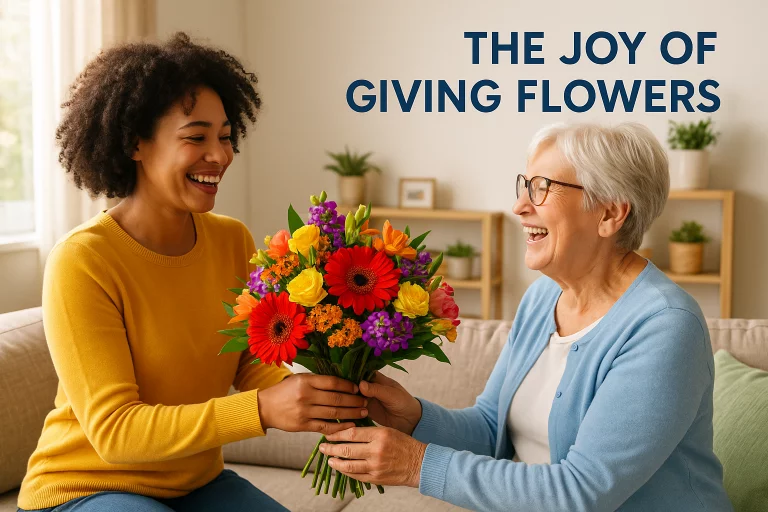Key Takeaways
- Flowers have the power to communicate emotions and strengthen relationships in a way that transcends words and cultural barriers.
- Gifting bouquets can uplift spirits, alleviate stress, and provide comfort in times of joy or sorrow.
- Personalizing flower bouquets adds significant value, ensuring that each gift resonates with the recipient.
- The tradition of giving flowers for special occasions, celebrations, and milestones is deeply rooted in every culture and remains relevant in modern society.
- Utilizing symbolism and thoughtful gestures when giving flowers can deepen the emotional connection between individuals, making memories that last far beyond the life of the blooms.
Introduction
Throughout centuries and across continents, flowers have transcended their natural beauty to become profound messengers of human sentiment. The simple act of gifting a bouquet can communicate layers of emotion that words sometimes struggle to convey, making flowers one of the most cherished forms of connection in every culture. Traditionally admired in gardens and wild landscapes, flowers are now intricately arranged into bouquets that celebrate milestones, signify admiration, and offer comfort in times of need. In our fast-paced world, sending or receiving a vibrant bouquet remains a timeless gesture of thoughtfulness, one that strengthens relationships and evokes heartfelt responses.
Today, flower bouquets hold an enduring significance in both personal and professional arenas. As a universal language of care, they bridge gaps between people—whether it’s rekindling affection in a romantic relationship, expressing gratitude to a mentor, or mending a rift between friends. For those seeking premium arrangements, flower bouquets Boston, MA, offer expertly crafted bouquets that highlight any occasion and create lasting memories, making every expression of emotion more meaningful and memorable.
The Emotional Impact of Flowers
Flowers possess a unique ability to elevate spirits and infuse spaces with positivity the moment they enter a room. Research across various disciplines, including psychology and neuroscience, has consistently demonstrated that the mere sight and smell of fresh flowers can induce happiness, reduce depressive feelings, and promote a general sense of well-being. Their vivid hues, intricate shapes, and delicate fragrances engage the senses, stimulating the release of endorphins and other “feel-good” hormones that instantly put both the giver and receiver in a better mood. According to the Society of American Florists, receiving flowers elicits immediate and lasting positive emotional reactions, confirming their role in enhancing psychological well-being.
During life’s most challenging moments—whether recovering from illness, navigating grief, or enduring stressful periods—a thoughtfully selected bouquet can provide tangible comfort and hope. These gifts also shine during moments of everyday life, where a spontaneous arrangement can bring light to an ordinary day, relieve inner tension, and remind someone that they are cherished. The transformational effect of flowers bridges differences in age, background, and culture, underscoring the emotional universality of gifting blooms.

Flowers as Symbols of Love and Affection
One of the most significant aspects of flower giving is its deep-rooted symbolism in matters of the heart. For centuries, civilizations have assigned specific meanings to various flowers, transforming them into powerful symbols of love, devotion, and admiration. Red roses stand as a global emblem of passionate love, favored by couples to convey intense romantic feelings. Conversely, flowers like lilies and orchids have grown popular as tokens of respect, purity, and rare appreciation, making them ideal for honoring friendships, family relationships, and even professional bonds.
Understanding the nuanced symbolism embedded in different flowers enables givers to craft bouquets that convey their unique emotions with precision and depth. For instance, yellow tulips can express cheerful thoughts and new beginnings, while blue irises signify hope and faith. As highlighted in Southern Living’s guide to flower meanings, even lesser-known blooms carry special significance, such as anemones symbolizing protection or hydrangeas representing gratitude and heartfelt emotion. Customizing bouquets based on these meanings enriches the exchange, imbuing each gift with intention and heartfelt resonance. Today’s bouquet givers continue to keep this floral language alive, finding new ways to celebrate birthdays, anniversaries, and everyday connections in a manner that words alone could never capture.
Strengthening Bonds Through Thoughtful Gestures
Strong relationships often thrive on the accumulation of small, considerate gestures—tokens of appreciation that nurture trust and intimacy. Within this realm, gifting flowers stands out as an act of intentional kindness, capable of warming the coldest day and bridging emotional distances. Whether presented during festive events or as a spontaneous act ‘just because,’ bouquets can revive fading connections or cement growing friendships by showing thoughtfulness and intent.
Significantly, the power of floral gifts extends far beyond romantic relationships. Within families, bouquets might be used to celebrate milestones, apologize for past misunderstandings, or simply express everyday gratitude. Among friends, flowers can lift spirits during difficult times or serve as a poignant reminder of joy during personal triumphs. Even in professional settings, recognizing a colleague’s achievement, welcoming a new member, or extending condolences through flowers can reinforce camaraderie and mutual respect. These gestures serve as visible affirmations of support, fostering an environment where relationships can be nurtured and flourish over time.
Flowers in Cultural Traditions
Throughout history, flowers have been integral to rituals, ceremonies, and traditions that unite communities and foster a sense of shared identity. Their symbolic power manifests in countless forms across cultures—for instance, the delicate cherry blossoms of Japan, which inspire annual Hanami gatherings that celebrate life’s impermanence and fleeting beauty. In India, lush garlands of marigolds adorn temples, homes, and brides, embodying concepts of purity, prosperity, and heartfelt devotion.
Western traditions have also woven flowers deeply into their cultural fabric. Joyous weddings overflow with lavish floral arrangements, symbolizing new beginnings, while somber occasions, such as funerals and memorials, feature lilies and chrysanthemums to convey peace, remembrance, and hope for the afterlife. Milestone moments, such as graduations, baptisms, and birthdays, are routinely marked with thoughtfully chosen bouquets, serving as both tokens of celebration and reservoirs of shared memories. The prevalence of flowers in global traditions underscores their unparalleled role as ambassadors of love, respect, continuity, and remembrance.
Psychological Benefits of Floral Gifts
Beyond their visual beauty, flowers offer a host of psychological benefits that contribute to holistic well-being. Scientific studies have shown that having flowers indoors can ease anxiety, lower cortisol levels, and even boost cognitive performance. Their calming presence transforms workspaces, bedrooms, and communal areas into oases of comfort, prompting users to unwind and feel more at home.
Engaging with flowers—by arranging, caring for, or simply observing them—encourages mindfulness and connection to the present moment. This simple ritual can interrupt cycles of worry, foster a sense of gratitude, and ignite creative inspiration. By integrating fresh blooms into daily routines, individuals often report heightened satisfaction and renewed motivation. Flowers thus serve dual roles: as beautiful decorative elements and as gentle catalysts for emotional harmony, self-reflection, and positive relationships.
Personalizing Flower Bouquets
Personalization is the cornerstone of a memorable flower bouquet. Taking the time to select blossoms that reflect a recipient’s preferences—whether it’s their favorite color, scent, or a bloom linked to a meaningful memory—adds layers of sincerity and warmth to the gesture. This attention to detail elevates the exchange from a generic present to a deeply personal token of affection.
Further customization may include selecting flowers that evoke shared experiences, incorporating locally grown varieties to create a sense of place, or crafting an arrangement that resonates with the recipient’s style and personality. Adding a handwritten note, perhaps with a message that aligns with the bouquet’s symbolism, reinforces the gift’s emotional impact. Over time, such thoughtful personalizations transform ordinary bouquets into treasured mementos, strengthening the unique connection between giver and receiver.
Conclusion
The role of flower bouquets in our lives extends far beyond decoration or tradition—they are powerful expressions of our feelings, capable of conveying what words cannot and nurturing the bonds that matter most. The simple act of gifting flowers can lighten burdens, ignite joy, and inspire gratitude, ensuring that relationships grow deeper and more resilient over time. Whether as grand gestures during celebrations or simple tokens of everyday affection, flowers remain timeless in their ability to connect hearts across generations.
As you reflect on the many ways you can enrich your connections with others, consider the enduring beauty and impact of a thoughtfully chosen bouquet. Whether you hope to rekindle romance, offer sympathy, or celebrate an achievement, let flower bouquets help you speak the universal language of love, care, and connection that only flowers can truly convey.

